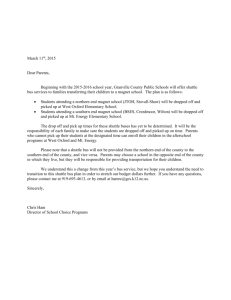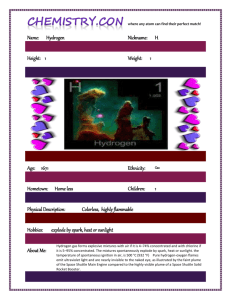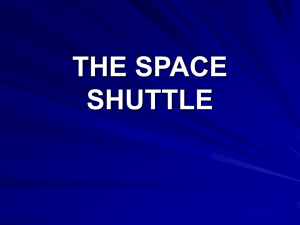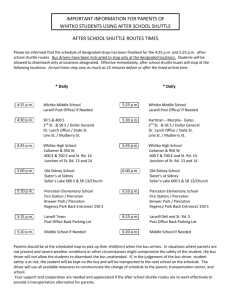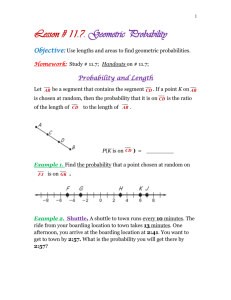The Arizona Airglow Experiment (GLO)
advertisement
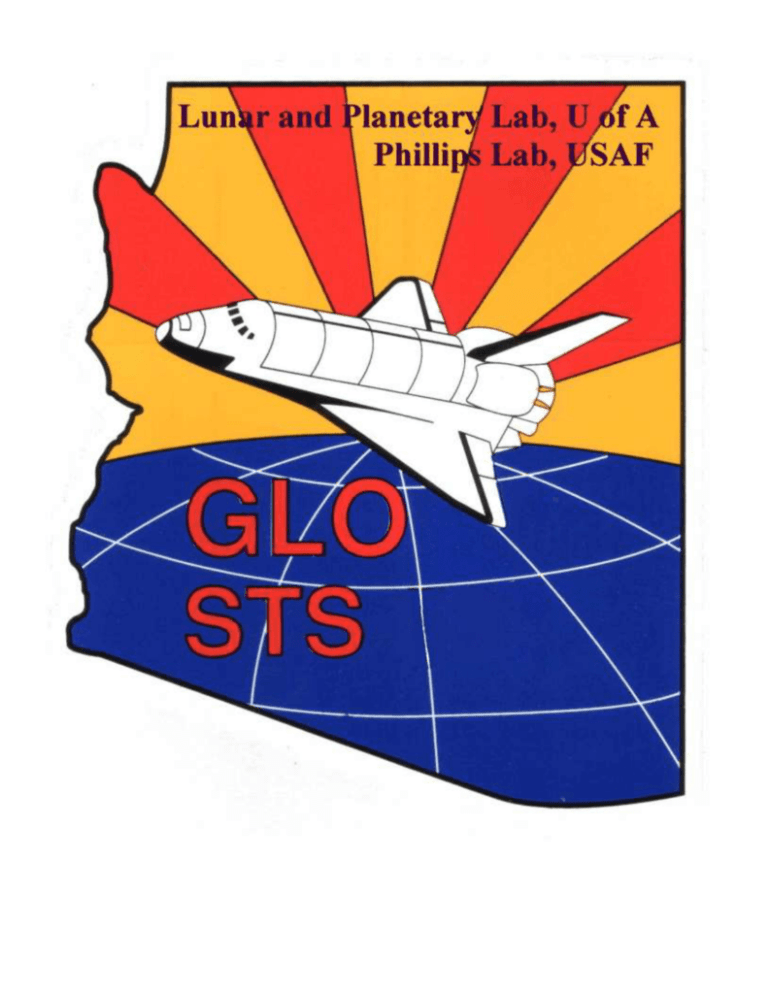
The Arizona Airglow Experiment Flew on These Missions Space Transportation System (STS) STS-39 STS-53 STS-53 Discovery May, 1991 STS-63 Discovery February, 1995 Discovery December, 1992 STS-69 Endeavour September, 1995 The Arizona Airglow Experiment Flew on These Missions Space Transportation System (STS) STS-74 Atlantis November, 1995 STS-85 Discovery August, 1997 STS-95 Discovery October, 1998 GLO Patch The Arizona Airglow Experiment (GLO) This instrument, Arizona Airglow Experiment, was designed to investigate the mysterious shroud of luminosity around the Shuttle observed by astronauts on Shuttle missions. The luminosity was called "Shuttle Glow" hence the origin of the acronym GLO. The experiment was sponsored by the USAF/Phillips Laboratory. The nature of the instrument made it ideal for studies of Earth's thermosphere. Consequently, it became a joint program with NASA's Space Physics Division of the Office of Space Science. The GLO instrument in modern terms is a 5000 channel hyperspectral imager. The data product is known as an image cube since there are three contiguous dimensional products recorded, 5000 spectral elements, 24 spatial elements and time. The airglow spectrum is recorded simultaneously from 115 nm to 900 nm at 24 levels in the atmosphere resulting in vertical profiles of every emitter in the spectrum every ten seconds. The hyperspectral imager is actually a set of five spectrographs that use nine holographic gratings and five intensified CCDs with appropriate photo cathodes to record the full spectral range. Support imagers were used to provide extra spatial information of important emission features. These imagers are intensified CCD cameras with band pass filters to isolate the OI(557.7 nm), the O2(Atmospheric) and OH(Meinel) emissions. A commercial CCTV camera was incorporated to validate instrument pointing from the command center. It was also used as an Earth limb and star tracker. GLO Flight Instrument Team Principal Investigator Dr. Lyle Broadfoot Mechanical Design Lyle Broadfoot Electronic Support Reuben "Bud" Hill, Baja Technology Software Support Kalynnda Berens, Michael Fitzgibbon Mechanical Fabrication Robert Kingsley, University Research Instrument Center This was a view of GLO (STS-53, 1992) in one of the two configurations for mounting instruments in the Shuttle bay. Here GLO and its supporting electronic boxes were mounted on standard plates that in turn were bolted to the sidewall of the Shuttle bay. The box on the right hand plate contained a digital recorder. The box was sealed and held at one atmosphere pressure and room temperature (20C). The lower box under the shelf contained two single board computers and control cards. The system was autonomous with stored operational software programs. The programs could be modified by ground command to respond to changing flight and experiment conditions. Further under the shelf were the low voltage and high voltage power supplies. All of these electronic units were designed and built here at the UA in the early 1990s. With advancements in electronic technology they could be replaced with of-the-shelf components incorporated into the spectrograph head. Another view of GLO installed in the Shuttle bay in the stowed position ready for launch. Special surface treatments were used to help control instrument temperature in space. The silver tape covering the spectrograph head improves radiation to space to lower the temperature of the detector head. The head temperature ranged between -10° and -20°C on orbit. The scan platform was covered with a solar blanket to minimize loss of heat. Solar blankets were made up of 12-24 layers of gold foil separated by Teflon mesh to minimize conduction. Each layer was grounded to the instrument to prevent electrical charge buildup. The scan platform had heaters to maintain laboratory temperatures, 20°C. A special white paint was used on other exposed surfaces. The cable bundles shown here were threaded up through the scan platform to the spectrograph head. The GLO scan platform allowed viewing in any direction out of the Shuttle bay. The range was ±135° in elevation and ±170° in azimuth. This picture was taken in a clean room at the Goddard Space Flight Center (GSFC), Greenbelt MD. The instrument team was integrating four AU instruments on the cross-bay "bridge" in preparation for STS-85 (Aug, 1997). The bridge was the other facility for carrying experiments into space. We assisted the Shuttle Small Payloads Project Office (SSPPO) to prepare the bridge for flight. Instruments and supporting electronic boxes were mounted on top and either side of the bridge. GLO-5 and GLO-6 would look over one wing of the Shuttle. The Ultraviolet Spectrograph Telescope for Astronomical Research (UVSTAR) and EUV Imager on the other end of the bridge would look over the other wing. The back side of the two 12 inch diameter mirror of UVSTAR can be seen between the two GLO. After installations was complete and all electrical and communication functions were verified the assembly was ready for flight. Then the bridge assembly was moved to the ElectroMagnetic Compatibility laboratory for test. Finally the assembly and test equipment were moved to the Kennedy Flight Center (KFC), Cape Canaveral, FL. At KFC the bridge and test equipment were reassembled for a post shipment validation test. Final adjustments to instruments and software were made. Note that GLO-6 was in a scan platform test program, it was at the elevation limit, -135, or upside down compared to GLO-5. The rear cover of UVSTAR was installed. The solar blankets were completed. Some electronic enclosure covers were removed for final adjustments. The GSFC engineering team, SSPPO, would turn the assembly over to the KFC engineers for installation in the Shuttle. Note also another bridge assembly was being prepared to the right. The bridge is installed across the Shuttle bay. It is attached to either sill with clamps around the posts under the orange protective covers. In this view the bridge had been released to the KSC engineers after system validation tests were completed. Here the “keel” is being attached to the bridge. The keel extends the bridge structure down to the bottom of the Shuttle bay to distribute the stress of launch across the Shuttle structure. The mass and position of each piece of hardware on the bridge is known and has been entered into a mathematical model to define the stress on the support structure. The results from the bridge model were included in an all-up Shuttle model a year or so earlier as part of the flight ready decision. Here the bridge assembly was being lowered into a mockup of the Shuttle bay as a mechanical fit test. The bay doors were closed to make certain there is proper clearance between the payload and doors. The next step was to move the assembly to the Vehicle Assembly Building (VAB) where it was installed in the Shuttle. The next view shows all of the in-bay payloads for the STS-85 mission installed in the Shuttle bay. The Shuttle was vertical when the payloads were installed. This was just before the doors were closed and the Shuttle was moved to the launch structure. . This is a good view of the bridge and the organization of the experiments. The electrical and communication connections were made to the Shuttle. Final checkouts were made through the Shuttle system all the way back to the Payload Operations Control Center (POCC) at GSFC. When the Shuttle was on orbit the GLOs and UVSTAR were in real time communication with the POCC about half of the time. During these periods recorded and real time data was transferred to the POCC at ~1.4 mbps. Some of the time video from the GLO CCTVs was used to complement GLO experiments. The instruments were autonomous having basic operational programs in memory. The programs could be modified by command from the POCC. The instruments operated continuously from the time the bay doors were opened until they closed, typically 8-10 days later.
